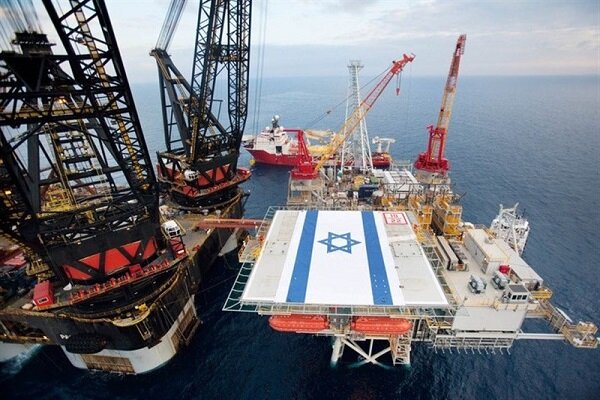The gas fields of the Zionist regime are in the crosshairs of Hezbollah

Mehr News, Intergroup International: The military strategy of the Zionist regime has taken on a more aggressive form after a year since the Al-Aqsa storm, and this regime has used its military power, especially in the northern borders, in the form of aerial bombardment and ground operations against Hezbollah has concentrated Lebanon. In this situation, the logic of the balance of power in West Asia leads the actors of the resistance axis to confront the power sources of the Zionist regime. One of the most important power sources of the Zionist regime is the energy (gas) fields located in the Eastern Mediterranean and is a determining factor among the power sources of this regime, especially in the economic field.
Energy is the new power source of the Zionist regime
The Zionist regime started producing natural gas from offshore fields in 2004, but the amount was less than the amount required for the regime’s self-sufficiency. In 2009-2013, several gas fields were discovered in the deep waters of the Mediterranean Sea. The most important fields are Tamar, Leviathan, Karish and Northern Karish.
Tamar gas field
This field was discovered in 2013 with an estimated capacity of 282 billion cubic meters and now produces 887 million cubic feet of gas per day. This field is located 24 kilometers west of Ashkelon in the north of the Gaza Strip. This field was affected by the Al-Aqsa storm operation immediately after the 7th of October, and with its closure, the gas export of the Zionist regime to Egypt was suspended.
Leviathan gas field and Gaza war
Leviathan is the largest gas field of the Zionist regime and is located near Haifa coast. The current value of the reserves of this field is estimated at 12.5 trillion cubic meters. In 2018, Netanyahu described this achievement as “a great revolution” and emphasized that “Leviathan will provide Israel with clean energy that will replace coal and increase the capital of state funds by billions of dollars.” The operation of the first phase of this field started in 2020 and it produces 1054 million cubic feet of gas per day. The high capacity of this field made Tel Aviv sign a gas export agreement with Europe in June 2022.
This square is the supplier of the Zionist regime’s exports after the start of Al-Aqsa storm and the closure of Tamar square. “Felicity Arbuthnot, an independent journalist, commented in a 2013 article: “While Israel claims this treasure is its own, much of this wealth lying at sea belongs to the people of Gaza. “ Shortly after the start of Al-Aqsa storm, the Hebrew website Mekomit published a 10-page confidential document from the Ministry of Information of the Zionist regime, in which the forced transfer of more than 2 1,200,000 people from Gaza have been referred to the refugee camp in North Sinai in Egypt. Some analysts consider this forced migration in line with the occupation regime’s attempt to own this gas field.
Carish gas field and the conflict with Lebanon
The Karish gas field is located 10 miles from Lebanese waters. 425 million cubic feet of gas is produced daily from this field. Since 2011, when Lebanon announced the coordinates of its maritime borders to the United Nations, this gas field has been the place of dispute between the Zionist regime and Lebanon. In October 2020, indirect technical negotiations between the two sides began and Lebanon presented its demands for demarcating the maritime borders in this field.
At first, the negotiations were supposed to be conducted according to the map that Lebanon sent to the United Nations in 2011, in which it estimated its maritime area to be 860 square kilometers. However, Beirut declared that the map was drawn based on a wrong estimate and demanded the annexation of an additional 1,430 square kilometers, which includes parts of its working field. With the rejection of this issue by the Zionist regime, the negotiations were also suspended. In November 2020, the Zionist regime, while officially announcing its opposition to Lebanon, emphasized that it would not negotiate outside of the limits set in 2011. At the same time, Hezbollah also warned Tel Aviv that it will react if the mining operation starts.
The vulnerabilities of the Zionist regime in gas fields
1. The Zionist regime, which was an importer of Egyptian gas before the discovery of these fields, now, in addition to being self-sufficient, exports gas to Egypt and the Kingdom of Jordan and is using this privilege to further improve relations with Arab countries.
2. The Zionist regime is eyeing the role of its gas resources, however small, to provide part of the energy needs of the European Union and to become an acceptable economic partner for Europe.
3. Gas exploration in the Mediterranean is an important field of cooperation in this region, and especially it has provided the main role in the restoration of relations between the Zionist regime and Turkey and the negotiations between the two sides regarding Cyprus.
3. The Zionist regime is also working on the development plan of Phase 1 Leviathan, Catlan and Tanin gas fields, all of which are located in the Mediterranean Sea. In June 2024, the energy minister of this regime also approved the proposed $500 million Leviathan offshore development project.
Hezbollah’s ability to target the gas fields of the Zionist regime
The extent of the investments of the Zionist regime on the aforementioned gas fields has made the vulnerability of these facilities against Hezbollah’s actions clearer. All three gas fields in the Mediterranean, especially the huge Leviathan field, are considered potential targets of Hezbollah. After announcing the Leviathan field development project, Hezbollah released a video showing the regime’s energy industries in the Mediterranean as potential targets. In this video, the latitude and longitude of Leviathan Square and the photos taken by Hezbollah drones were directly mentioned.
This Leviathan gas field is located eighty miles below the seabed off the coast of Haifa, but its production platform is located a few miles away from the city of Zicheron Yaakov and is easily accessible. It is within the reach of Hezbollah missiles. The Zionists’ fear of Hezbollah’s threats is mostly related to medium-range missiles and unmanned aerial vehicles that Hezbollah has. On October 1, 2024, Hezbollah flew a suicide drone towards the Karish gas field. took off
Result
Hizbollah is capable of threatening the gas fields of the Zionist regime at least in the short term. At the domestic level, despite the threats of Hezbollah and the unstable economic situation of the Zionist regime, the preparation of additional phases, especially in Leviathan Square, will take at least a few years. Despite the announcement of the Zionist regime about welcoming investments in the Mediterranean energy sector, such an action does not create an attractive prospect in the shadow of increasing tensions. The power of Hezbollah at the regional level also has a significant impact on gas discoveries in the region centered on the occupying regime. For example, Cyprus, which has close relations with the Zionist regime, is discovering a new gas field in this area, but its investors are worried about threats from Hezbollah.
Sajad Moradi Kalardeh, researcher of international relations


